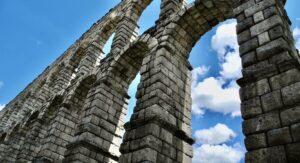
Engineering miracles. That is what the ancient Romans should best be remembered for.
Many other nations of antiquity assembled mighty armies that conquered far and wide. Many raised imposing architecture that dazzled the eye. But none could hold a candle to Rome’s mind-boggling achievements in engineering, particularly when it came to managing water.
When an oracle warned that a certain enemy would never be defeated as long as there was water in Lake Albano, Roman hydraulic engineers simply drained the lake bone-dry, paving the way for the vaunted legions to overcome the Veiians. Whenever the imperial government had an unwanted river on its hands, the corps of engineers would merely re-route the stream and fling it over some handy cliff. When a greater water supply was needed to accommodate a rapidly expanding population, the same genius would design pipelines to reach out great distances to snatch water from pure mountain streams and bring it rushing down into the City on the Tiber. Since the pipelines would lead (duct) water (aqua) from one place to another, they were given the name “aqueducts.”
Watering Rome
By 312 B.C. the city’s population had reached such numbers that its previous sources of water – natural springs, wells, cisterns, and the Tiber – no longer sufficed. Thus it was in that year that Appius Claudius, as censor, gave old Rome the first of its eventual eleven aqueducts. (Censors were responsible not only for safeguarding public morals but also for authorizing and supervising public works.) Actually, it was a co-censor, Gaius Plautius, who discovered the mountain stream and planned the pipeline that would channel the water into the city. But he retired from the elective office before the start of work on the plan, leaving Appius to oversee the construction and completion of the project and to give it his name. This pipeline, the Aqua Appia, redirected some of the water from a spring in the Alban Hills, ten miles to the south, down into the southern corner of Rome, more precisely into the “Greek quarter,” in the valley between the Aventine and Palatine hills.
____________________________
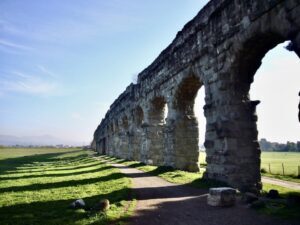
The Aqua Appia. Lalupa, CC-BY-SA 4.0, Wikimedia Commons
____________________________
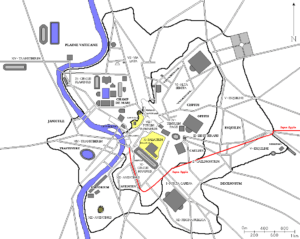
Map of Aqua Appia in Rome. Coldeel, CC-BY-SA 4.0, Wikimedia Commons
____________________________
In 273 B.C. another aqueduct was added, this one drawing its supply from the River Anio that rushes tumultuously down from the Sabine Mountains, about thirty miles east of Rome. (Originally called simply “Anio” it took on the name Anio Vetus (old) when a second aqueduct, drawing from another stretch of the same river, was completed, earning the name Aqua Anio Novus (new). A century and a half later, a public official named Marcius Rex gave Rome the Aqua Marcia. “The dearest of all streams on earth, unsurpassed in coolness and salubriousness, a true gift of the gods to Rome,” was how Pliny the Elder enthused over it.
____________________________

Remains of the Aqua Marcia and Aqua Tepula. Chris 73, CC-BY-SA 4.0, Wikimedia Commons
____________________________
This was a very ambitious undertaking. Stretching for fifty-six miles, it came with a final price tag of just under 180,000,000 sesterces i.e. about nine billion of today’s U.S. dollars. It supplied enough water to nourish nine of the fourteen precincts into which Rome was later divided by Caesar Augustus.
The year 125 B.C. saw the completion of a fourth water-works, the Aqua Tepula, so called for the tepid temperature of its stream (62 degrees Fahrenheit). This, however, was not fit for drinking. Incidentally, there are many under the impression that the aqueducts’ use was strictly for slaking the thirst of the populace. The fact is that the water also supplied the public baths and gardens, nymphaea, spectacular monumental fountains that were solely for the city’s esthetics, and private homes and villas of the very wealthy. Any overflow went toward flushing latrines and sewers.
During the reign of Augustus, a feverish building boom resulted in new urban problems, one of which was an inadequate water supply. In consultation with his chief adviser, Marcus Agrippa, the emperor commissioned the construction of the Aqua Virgo. This pipeline provided deliciously pure spring water from about nine miles to the east, up toward Tivoli. It is about a meter and a half in width and was built primarily to furnish the water for the Baths of Agrippa, a sumptuous spa in the section of Rome called, since ancient times, the Campus Martius. (Virgo is Latin for “virgin.” Agrippa so named the facility because one day a lovely young girl is said to have shown a company of his soldiers, parched with thirst, the location of the spring.)
The wonderful British writer H.V. Morton once had the opportunity to visit the site of Aqua Virgo’s source and tells this charming anecdote: “I was watching these very waters rushing by, knowing that twenty-four hours from now [that’s how long it took for the channeled water to reach the City] they would form the cascades of the fabled Fountain of Trevi and be the subject of hundreds of photographs snapped by an army of wide-eyed tourists.”
____________________________
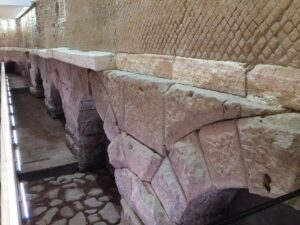
60 metres (200 ft) stretch of the Aqua Virgo arches, recently found inside the Rinascente shopping complex. Alexxant, CC-BY-SA 4.0, Wikimedia Commons
____________________________
The Augustan era also saw the addition of two more aqueducts, the Aqua Julia, which tapped into a cool mountain stream about fifteen miles out from Rome, up above the picturesque hill-town of Grottaferrata; and the Aqua Alsietina, which drew from aquifers near Lake Bracciano, some thirty two miles or so to the north, toward the old, still walled-in Etruscan city of Viterbo. The water, however, was non-potable and used for the naumachia (an artificial lake for mock naval battles) in the trans Tiber district.
So big was this business becoming that by the late first century a full-blown Water Bureau, with offices adjacent to the Roman Forum, was established. This was headed by a commissioner with what today would be considered “cabinet status.” One of the most distinguished of these department heads, or Curatores Aquarum, was Sextus Julius Frontinus. Appointed by the Emperor Nerva in A.D. 96 and re-appointed by Trajan in 98, Frontinus wrote De Aquis Urbis Romae, a technical manual on Rome’s waterworks that is most instructive on the techniques of aqueduct-building. In the preface, he thanks and praises the man who gave him the prestigious post:
“Nescio diligentiore an amantiore rei publicae imperatore Nerva Augusto….
“I do not know anyone who is more diligent, or who loves the State more, than the emperor Nerva Augustus.”
Frontinus goes on to say that since the position had always been assigned to the most outstanding men of the community, “per principes semper civitatis nostrae viros,” and since the task of the Water Commissioner involves the health and well-being and even the safety of the city, “ad salubritatem atque etiam securitatem urbis pertinens,” he takes the office entrusted to him with the utmost sense of commitment and seriousness.
Form and Function
Such an abundance of water was the fruit of the hydrogeological character of the hilly and mountainous territory surrounding Rome, containing cascading streams by the hundreds. First of all, the source of an aqueduct has to be higher than its destination. Some of the streams originated from over a thousand feet above sea level. Each pipeline – in order to function effectively – had to maintain a slight slope to assure that the downward flow of the water retained its velocity continuously to the destination.Thus the whole enterprise depended not on pumping stations but on gravity.
The conduit was mostly underground. En route to the city there were hills that had to be penetrated. When confronted with valleys and lowlands the water channel had to be borne aloft by arch-supported bridge-like structures, the ruins of which, in some instances, still grace the Roman Campagna. This segment of an aqueduct consisted of a flat-bottomed channel, about three feet wide and five feet deep, and was open to the sky, hence vulnerable to debris and clogging. Such “bridges” maintained a steady gradient.
These waterworks were therefor not only wonders of engineering but also masterpieces of architecture, as Vitruvius points out in his book, “De Architectura”. The French writer Chateaubriand, on his grand tour of Rome, marveled that the ancient aqueducts had brought water to the Eternal City “on arches of triumph.” One need only visit Nimes in France and view the Augustan era Pont du Gard spanning the Gardon River, at the giddy height of a hundred and sixty feet, to agree with both authors; or travel to Segovia in Spain to observe its soaring, remarkably preserved Roman aqueduct. (There were eventually hundreds of aqueducts across the far-flung Empire.)
The earliest of Rome’s aqueducts had pipelines generally of lead, which created difficulties in soldering and/or welding. The builders ultimately had to resort to using terracotta conduits, coated in a smooth-surfaced volcanic cement called pozzolana.
With most aqueducts the water of a stream or spring was first led into a nearby concrete “springhouse”, thence into the main pipeline. The course of it finished – in the city – in a “castello,” which was a massive, towered structure containing one or more chambers of decantation and a vast reservoir from which the water was redistributed into smaller urban conduits.
As for maintenance, there were crews made up of slaves and plebeians, with only the latter, of course, getting a “paycheck.” These workers, called aquarii, had to deal with problems such as leakage, loose debris and soil blown up by winds and storms, clogging by calcium carbonate deposits that narrowed the walls and had to be scraped away, and illegal tappings by farmers and vineyard owners whose lands happened to be hard by the route of the aqueduct. (Despite the strict laws and severe penalties against such mischief, it somehow persisted)
As for security, there were guards and patrols, night and day, at the source site and at other vulnerable areas. The fact that an aqueduct ran either underground or up on arches, a hundred feet high or more, was in itself a built-in form of security.
For private property owner subscribers the water bills became major headaches. Still, they paid willingly for the luxury. Indeed, there was quite a long waiting list for the service. In one letter, the satirical poet Martial gripes about getting the runaround from the haughty bureaucrats after applying for a pipeline to his estate. Yet, Martial’s allegations aside, a position at the waterworks was not the usual political sinecure. There were no, so to speak,”water-cooler jobs” to be had. The clerks, engineers, mechanics, masons, and unskilled laborers were kept busy all hours of the day and night with complaints of pressure failure. More woes were caused by the periodic necessity of shutting off the pipelines to clean them of their lime deposits.
* * * * * * * ** *
In A.D. 38, the mentally unbalanced Caligula ordered work to begin on a new aqueduct that would bring water from springs near Subiaco, about forty miles east of Rome. Taking fourteen years to construct, it was completed in the reign of Emperor Claudius, who gave it the name Aqua Claudia. The most important of all these ancient Roman projects, it was called “Magnificentissima” by Frontinus. Underground for the most part, it went overland on a series of sturdy lofty arches for its last nine miles, ending with excellent pressure up on the Caelian Hill. It was later extended across a valley to the Palatine Hill so that it could serve the imperial palace and grounds. In A.D. 1587, Pope Sixtus V utilized what remained of it to construct an up-to-date facility which he called the Aqua Felice. (His given name was Felice Peretti.) Today it nourishes the zones of the Esquiline, Quirinal, and Viminal hills but is largely utilized for the splendid fountains of the city’s historic center, including the terminus: The Fountain of Moses.
______________________________

View of the Aqua Claudia. Chris 73, CC-BY-SA 4.0, Wikimedia Commons
______________________________
On the subject of restoration, it was another pontiff, Pope Paul V, who got the Aqua Traiana up and running again, renaming it, naturally, the Aqua Paola. Emperor Trajan had this aqueduct built in the year 119, drawing its water from springs up in the Sabatini mountains to the north, over a course of nearly forty miles. In our time, as it did in antiquity, it still services the Janiculum Hill and trans Tiber district below it. (That quarter of the city is today’s colorful, ever popular, Trastevere.) The terminus of this waterway is the immense – and immensely beautiful – Fontana Paolina with its five cascades, a name which inadvertently honors both the architect (Domenico Fontana) and the patron (Paul).
Besides the Claudian and Trajanian works, two others were rehabilitated by popes: the Aqua Marcia by Pius IX (who renamed it Aqua Pia), and the Virgo by Nicholas V.
(What necessitated these later restorations was the result of the A.D. 537 Ostrogoth siege of Rome, thirsting the Romans into submission by cutting the aqueducts and choking off the water supply. When the dust finally settled after the last barbarian invasion, Rome deteriorated into a veritable, uninhabitable ghost town, its population dwindling from a peak of a million at the height of the imperial era to a scant fifteen thousand through the early Middle ages.)
The last of the eleven aqueducts of Republican and Imperial Rome was built by order of Emperor Alexander Severus in A.D. 226 and bore his name: Aqua Alexandrina. Its source was a number of springs in the Sassolello Hills, twelve miles north, near the old city of Gobi. Its main purpose was to provide the water for the Neronian Baths.
________________________________
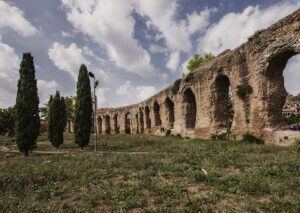
The Aqua Alexandrina. Paola Pittori, CC-BY-SA 4.0, Wikimedia Commons
________________________________
The great historian Edward Gibbon paid this eloquent tribute to these civil engineering wonders: “The boldness of the enterprise, the solidity of the execution, and the uses to which they were subservient, rank the aqueducts among the noblest monuments of Roman genius and power.”
For the Romans of antiquity, these endlessly astonishing hydraulic projects exponentially improved the quality of life – and hygiene. Their hauntingly romantic ruins speak in silent eloquence of the grandeur of long-ago Rome, which even as long ago as its heyday had already acquired two popular and poetic nicknames: Urbs Aeterna (The Eternal City) and Caput Mundi (The Capital of the World). When those eleven mighty aqueducts were in their prime, they bestowed on Rome yet another sobriquet: Regina Aquarum …”Queen of the Waters.”
_________________________________
Cover Image, Top Left: View peering up at a Roman aqueduct. Herlindeadler, Pixabay
_________________________________
Advertisement

See the incredible archaeology, architecture, and art of northern Spain. A unique tour with special expert guides and lecturers through the collaboration of Popular Archaeology Magazine and Stone & Compass Tours. Not to be missed. Read More About It: https://popular-archaeology.com/article/northern-spains-triple-a-archaeology-architecture-and-art/.
_________________________________




